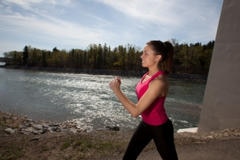"If you’re like the majority of weightlifters and just want to be stronger and more muscular, then ditch all the broscience and just focus on git ‘er done."It’s time to proactively synergize your core competencies toward an optimized fitness paradigm! Or something.
Welcome to James Fell's Strategic Fitness series.
Much of the focus on fitness is on micro details of sets, reps, nutrient timing, blasting bigger biceps and shredding that last gram of fat from your midsection. I don’t play there but rise above it. I’m a certified strength and conditioning specialist with an MBA, and Strategic Fitness is about the big picture of fitness, health and physical performance. We’ll work on making you pretty from the neck down in a way that takes your entire life into account. In this installment, I'll discuss my three-day workout routine.
I’ve been using the same split-routine for working out for well over a decade. The horror!
I know there is much in the weightlifting world -- especially by self-styled experts with blogs and writing skills that make me think their mom didn’t do such a good job childproofing the house when they were little -- who insist that every parameter of your routine needs to change regularly in order to BLAST YOUR TRAINING TO AN ALL-NEW LEVEL!
What a bunch of tools.
Yes, there are things you can do that involve maximizing every bit of your workout routine, but how much does that apply to you? Are you getting onstage all waxed, oily, tanned and Speedo-ed to flex for the crowd? No? Then maybe you need to read this piece of mine about focusing on the 90%.
If you’re like the majority of weightlifters and just want to be stronger and more muscular, then ditch all the broscience and just focus on git ‘er done.
“There is no data showing the 101 different ways of lifting is any better than focusing on a small number of core movements,” Stuart Phillips, a professor of Kinesiology at McMaster University, told me. “Personal training has become like men’s razors.” The latest gimmick sells.
So avoid those gimmicks and stick with what works for you. Let me tell you about a three-day workout that works for me, and why.
Actually, it’s been a while since I linked to my torso. I’m not a bodybuilder. I have never stepped on a stage, and I take no supplements except a glass of milk post workout. I’m a guy in his mid 40s who wants to look good for his wife. If I’m too puny for you, go read something else.
Back now? Going to stick around? Great. Let’s do this.
Push – Legs – Pull
That’s all you have to remember.
Day 1: Push
It is important to note that this is Upper Body Push. It’s all the exercises that involve pushing away from your upper body. Broken down in the simplest terms, it’s chest, shoulders and triceps. It can make for a pretty big workout, and I’ve found a way to make it more efficient to save time.
It’s important to focus mostly on chest, because that also works the shoulders and triceps. I’d say it is about 70% chest, 20% shoulders and 10% triceps. If it seems like shoulders and triceps are getting the short end, remember that every single chest workout is also training the other two, so don’t fret.
Chest is pretty hardcore, so I need rest breaks between sets. But with shoulders and triceps, I do a bit of switching back and forth to save time. It’s not quite supersetting, and it doesn’t qualify as compound sets either. It’s not-stopping-to-rest-between-sets-ing.

















